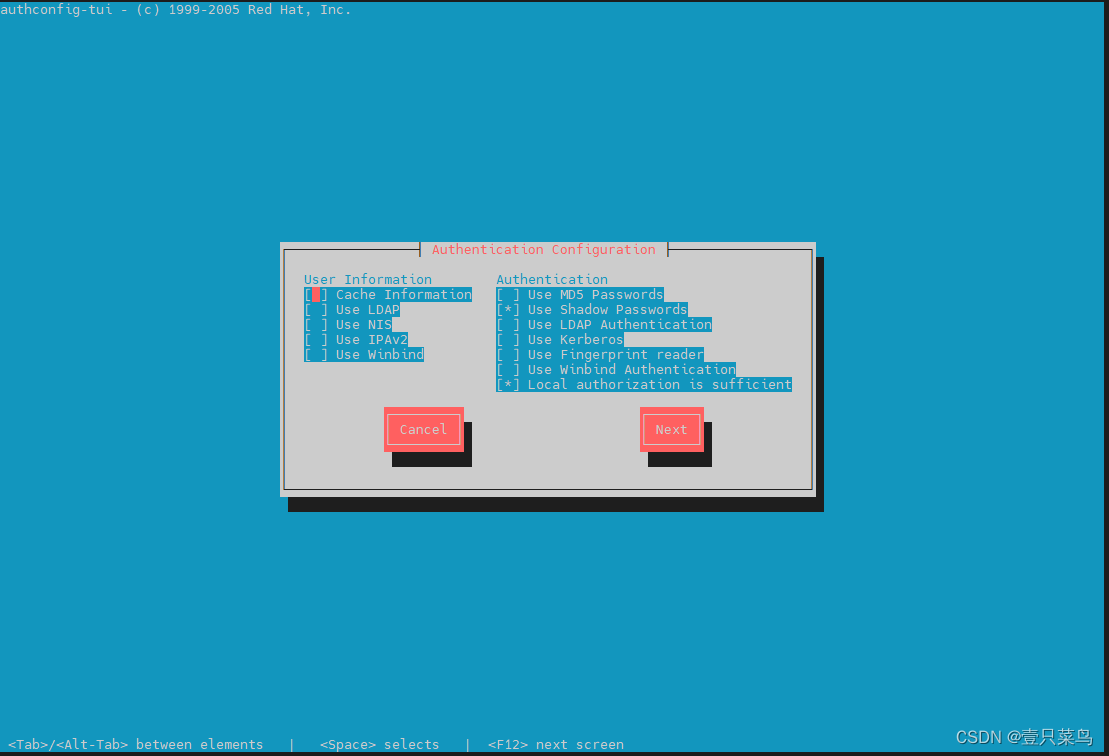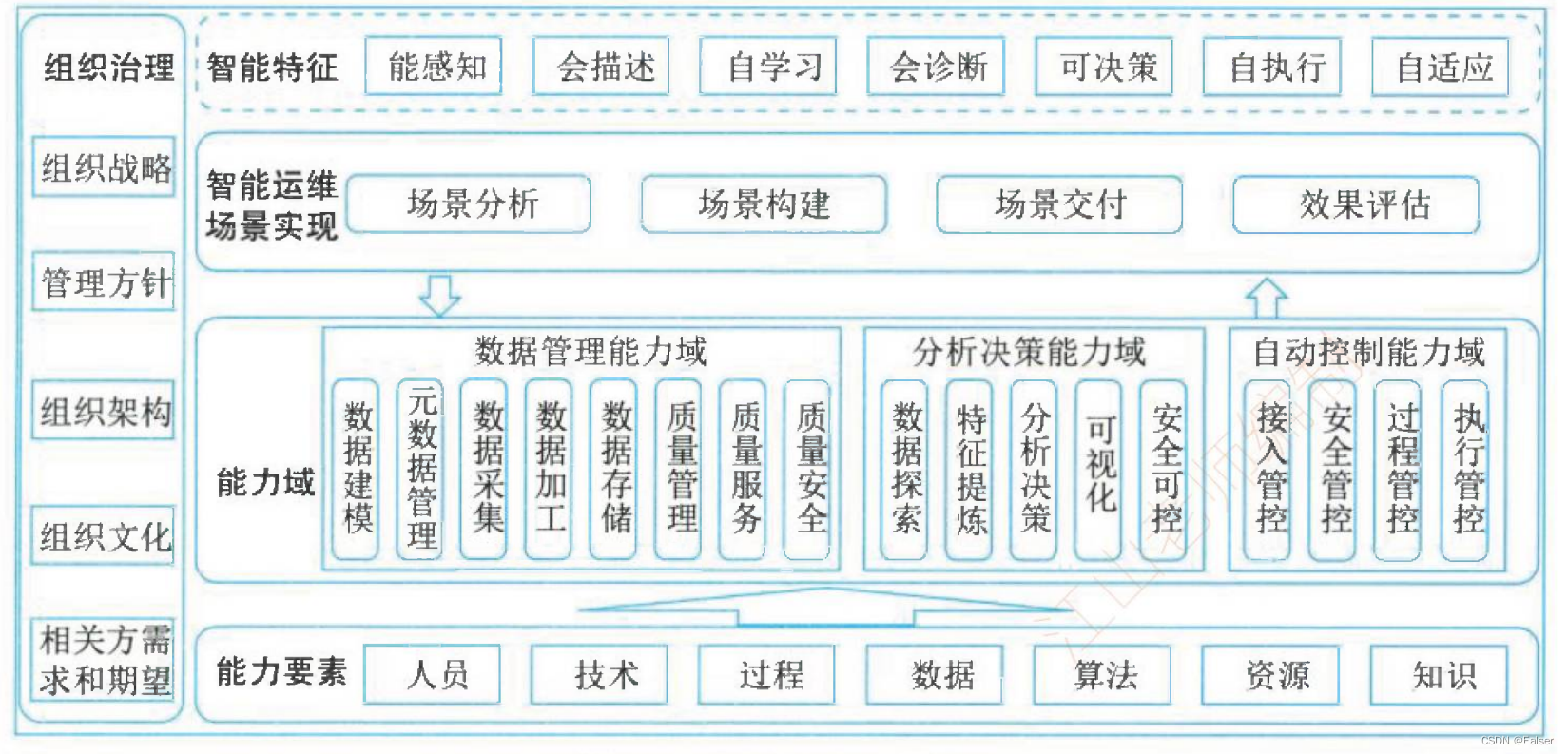一、AOP简介
AOP(Aspect Oriented Programming)面向切面编程,一种编程范式,指导开发者如何组织程序结构。
AOP是OOP(面向对象编程)的进阶版。
作用:在不改变原始设计的基础上为其进行功能增强。
spring理念:无侵入式。
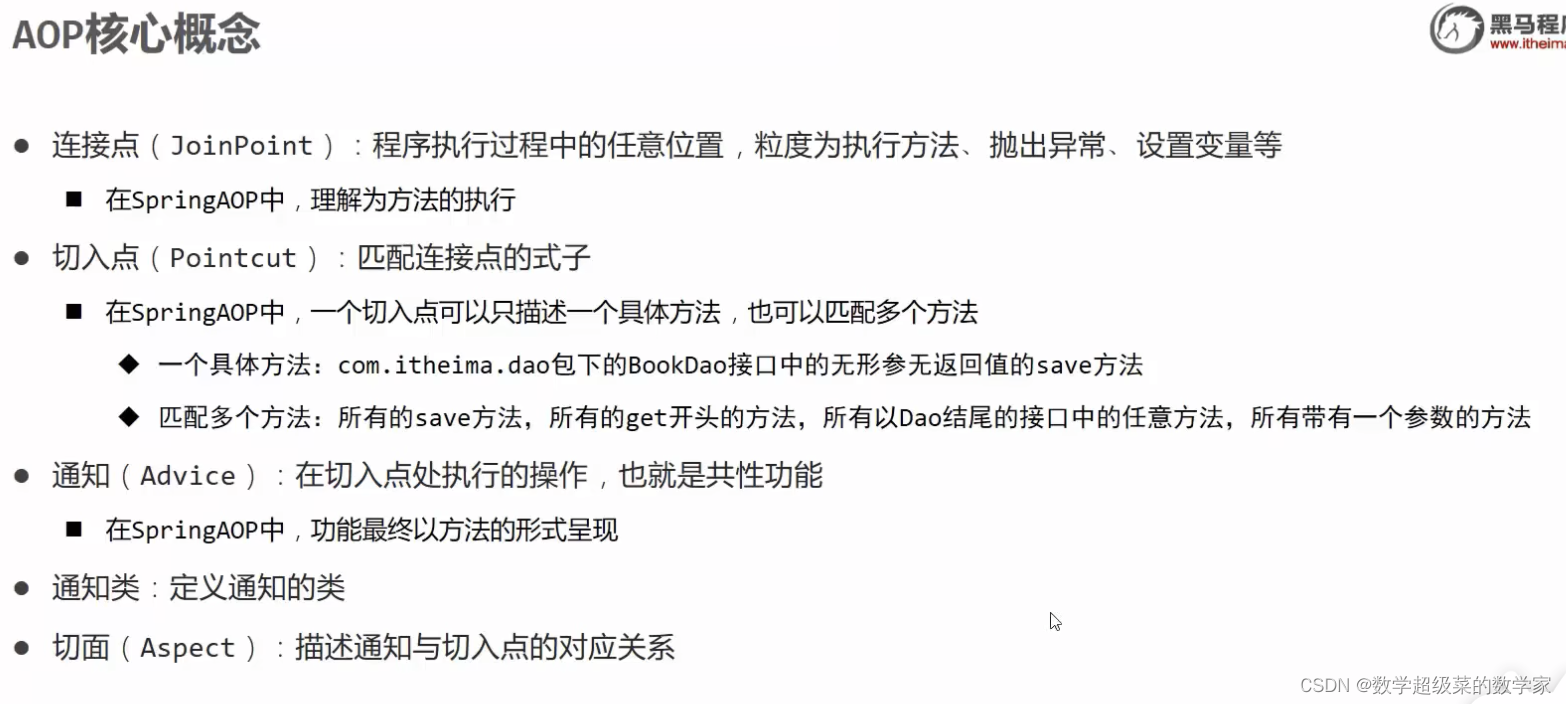

二、AOP入门实例
1、pom.xml导入坐标:注解开发(spring-context)、切面编程(aspectjweaver)
2、配置类SpringConfig 内添加注解@EnableAspectJAutoProxy (开启spring对AOP注解驱动支持)表示要注解开发AOP
3、通知类MyAdvice:定义通知(功能)、定义切入点(位置)、定义切面(绑定通知和切入点)
@Component //定义通知类受spring容器管理(让spring加载此通知类)
@Aspect //定义当前类为切面类(让spring明白此类 是做AOP的)//在此类定义通知(共性功能)
public class MyAdvice {//定义切入点(本质上就是确定要加功能的方法的准确位置)(// 依托一个不具有实际意义的方法进行,即无参无返回值,方法体无实际逻辑)@Pointcut("execution(void com.itheima.dao.BookDao.update())")private void pt(){}//将切入点(位置)和通知(功能)绑定@Before("pt()")//定义通知(本质就是要添加的功能)public void method(){System.out.println(System.currentTimeMillis());}
}三、AOP工作流程
springAOP本质:代理模式
如果切入点能和我要造bean的那个类匹配上对应的方法,则造代理对象;否则造原始对象
打印对象的getClass()方法(如bookDao.getClass())就可以看见是代理对象还是原始对象

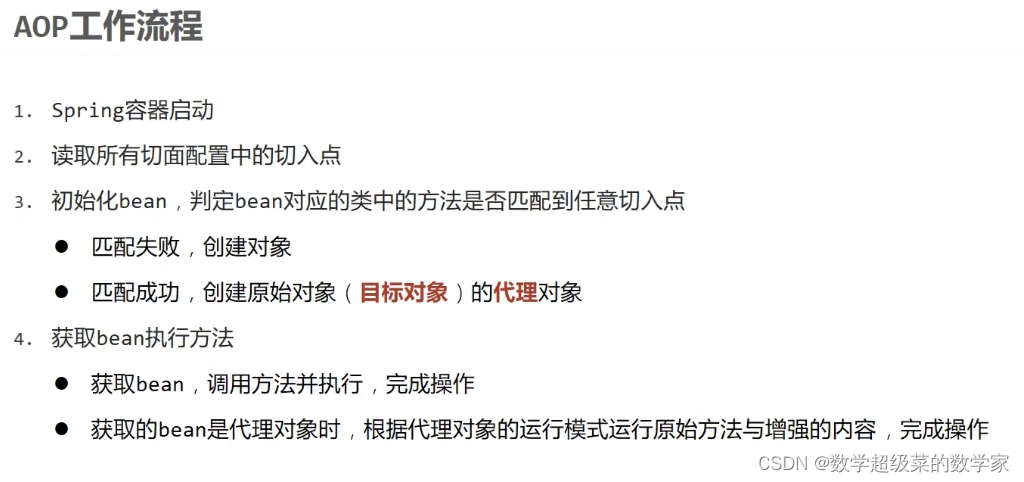
四、AOP切入点表达式
切入点定位到接口 & 实现类均可(但是写到实现类就紧耦合了,所以不写)
@Pointcut("execution(void com.itheima.BookDao.updata())")
@Pointcut("execution(void com.itheima.dao.impl.BookDaoImpl.updata())")
1、语法格式:
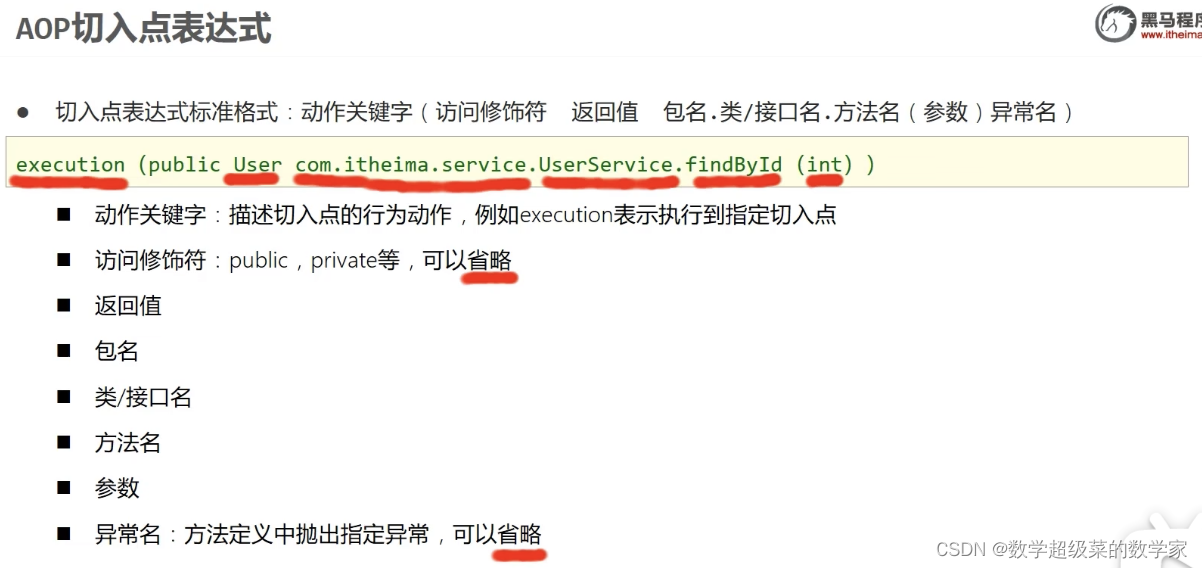
2、通配符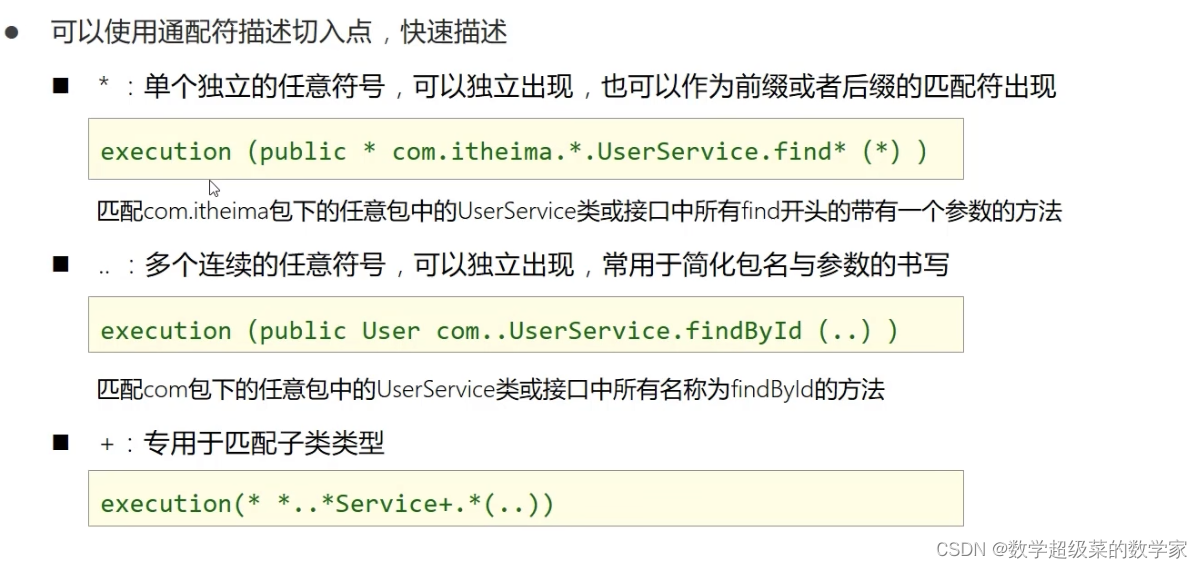
3、书写技巧

五、AOP通知类型<5>
<AOP通知描述了要添加的共性功能,共性功能要添加到切入点的合适位置。> AOP通知共分为5种类型:
前置通知、后置通知、环绕通知(重点)、返回后通知(了解)、抛出异常后通知(了解)
注意:环绕通知对原始方法调用以后,原始方法的返回值可以接出来,最终还要手动给送回去。下文中环绕通知即为规范格式。
@Component //定义通知类受spring容器管理(让spring加载此通知类)
@Aspect //定义当前类为切面类(让spring明白此类 是做AOP的)//在此类定义通知(共性功能)
public class MyAdvice {//定义切入点(本质上就是确定要加功能的方法的准确位置)(// 依托一个不具有实际意义的方法进行,即无参无返回值,方法体无实际逻辑)@Pointcut("execution(void com.itheima.dao.BookDao.update())")public void pt1(){}@Pointcut("execution(int com.itheima.dao.BookDao.select())")public void pt2(){}//将切入点(位置)和通知(功能)绑定@Before("pt1()")//前置通知public void before(){System.out.println("此处是增强添加的通知,并且是一个前置通知");}@After("pt1()")//后置通知public void after(){System.out.println("此处是增强添加的通知,并且是一个后置通知");}@Around("pt1()")//环绕通知public Object around(ProceedingJoinPoint pjp) throws Throwable {System.out.println("此处是增强添加的通知,并且是一个环绕通知");Object ret = pjp.proceed();System.out.println("此处是增强添加的通知,并且是一个环绕通知");return ret;}剩下俩个为:
@AfterReturning("")
@AfterThrowing("")
此处可以利用around对原始方法进行《隔离》!
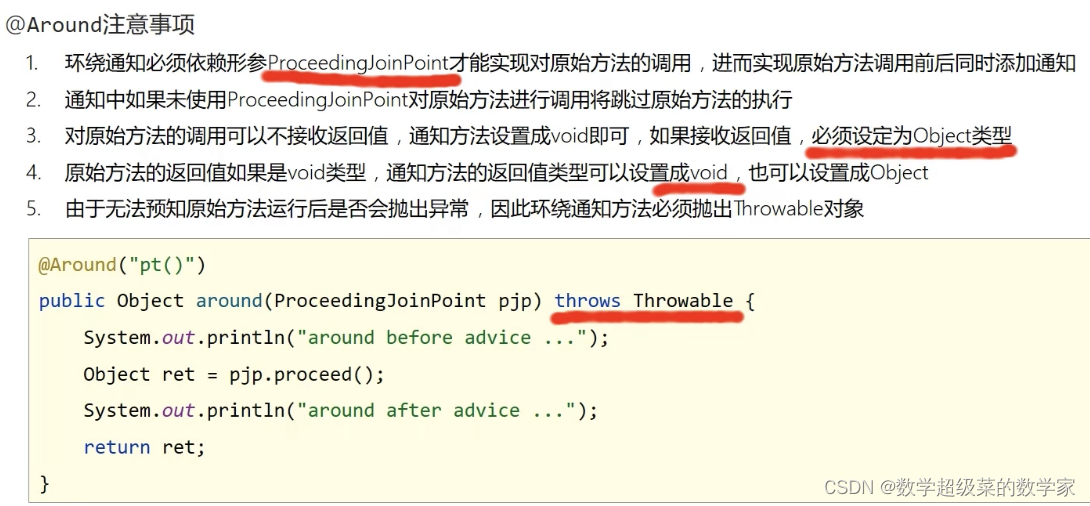
六、万次执行效率测试
测试业务层:
切入点表达式要确定业务层
@Pointcut("execution(* com.itheima.dao.*.*())")public void pt1(){}采用环绕通知获取执行万次的前后系统时间
@Around("pt1()")public void method(ProceedingJoinPoint pjp) throws Throwable {//获取执行签名信息Signature signature = pjp.getSignature();//通过签名获取接口名String className = signature.getDeclaringTypeName();//通过签名获取方法名String methodName = signature.getName();long start = (int) System.currentTimeMillis();for(int i = 0; i < 10000;i++){pjp.proceed();//此处代表执行业务层一万次}long end = (int) System.currentTimeMillis();System.out.println("执行一万次" + className + "." + methodName +"--->" + (end - start) + "ms");}七、AOP通知获取数据
AOP是对原始方法进行增强的,必然要知道原始方法的数据。
基本操作:在通知的方法的参数内加上接口,调用接口的方法来获取原始方法的参数。
获取的数据有三类:原始操作的参数、原始操作的返回值、原始操作的异常。
每种类型的数据只有五类通知的部分可以获取:
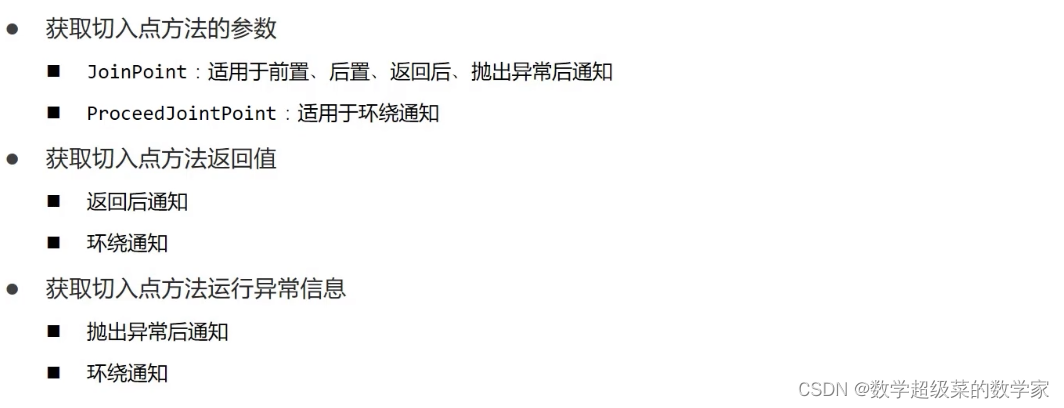
1、获取参数
获取的参数类型为数组;对于前置通知获取参数后,可以对数据检验错误、修改等操作。
//将切入点(位置)和通知(功能)绑定//@Before("pt1()")//前置通知public void before(JoinPoint jp){System.out.println("此处是增强添加的通知,并且是一个前置通知");Object[] args = jp.getArgs();//此方法getargs获取参数是数组类型System.out.println(Arrays.toString(args));}
后置、环绕、、都一样。
2、获取返回值
@Around("pt1()")//环绕通知
public Object around(ProceedingJoinPoint pjp) throws Throwable {Object args[] = pjp.getArgs();return ret;3、获取异常信息
@AfterThrowing(value = "pt1",throwing = "t")public void afterThrowing(Throwable t){System.out.println("返回异常" + t);}//注意通知的方法的参数要和标签的参数一致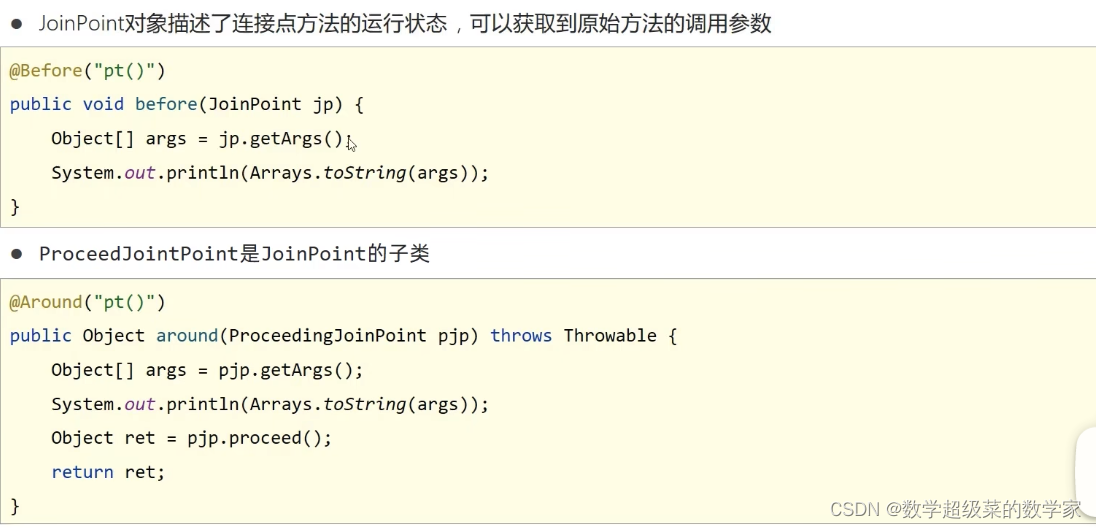
八、百度网盘粘贴:字符串匹配自动处理多余的空格
AOP增强
@Component
@Aspect
public class DataAdvice {//定义切入点@Pointcut("execution(boolean com.itheima.service.ResourcesService.openURL(..))")public void pt(){}@Around("pt()")public Object trimStr(ProceedingJoinPoint pjp) throws Throwable{//提前获取参数 将参数修改后在传参给原始方法内Object args[] = pjp.getArgs();for (int i = 0; i < args.length; i++) {if(args[i].getClass().equals(String.class)){//判断是不是字符串类型args[i] = args[i].toString().trim(); //是字符串类型就trim}}Object ret = pjp.proceed(args);//将空格处理后的参数在传参给要执行的原始方法return ret;}
}
十一、AOP总结
回忆。
要会啥呢?
1、得知道pom.xml文件里面要配置spring-context依赖(spring注解开发)、aspectjweaver依赖(AOP注解和切入点表达式,AOP核心功能已经被加载到spring-context依赖了)
2、知道要在spring核心配置类中加载AOP
3、得知道在AOP配置类中加载扫描啥的 切入点表达式会写。@Pointcut(“”execution())
4、环绕通知@Around(“”)参数ProceedingJoinpoint pjp
要写固定的执行原始方法得到返回值Object ret = pjp.proceed(args); return ret;
以上这些都是固定的。
5、根据不同的需要,通知类里面的方法咋写就看自己的了。


